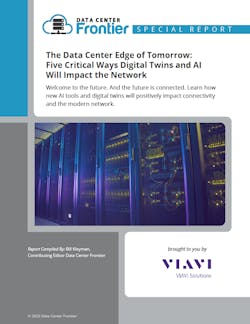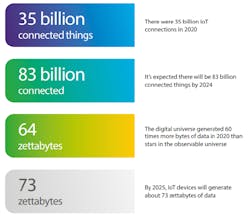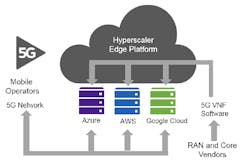Connectivity Modernization: Where We’ve Been, Where We’re Going
Last week we launched our article series on the positive impact that digital twins and AI will have on connectivity and the modern network. This week, we'll explore new design and partner considerations and how to overcome connectivity challenges in the digital age.
As we examine global connectivity trends, we see that the past four years have been a perfect storm for infrastructure and connectivity modernization. However, many infrastructure leaders were surprised at the rapid evolution of connected systems and general connectivity. And not all of them are ready to take on modern business requirements.
Research from ABB indicates that just 29% of data center decision-makers say their current facilities meet their needs, and only 6% say their data centers are updated ahead of their needs. Security (45%) and bandwidth (43%) are the most needed upgrades.
Globally, bandwidth and internet connectivity requirements continue to grow as well. A new report from TeleGeography states that global internet bandwidth increased by 28% in 2022. Total international bandwidth now stands at 997 Tbps, representing a four-year growth of 29%. As it stands, we have been seeing a near tripling of bandwidth since 2018. It becomes clear why we’ve crossed into the zettabyte era.
By 2025, the digital universe is expected to reach 175 zettabytes, which amounts to 150 times more bytes of data than stars in the observable universe. The numbers are staggering, but the hyperscale and data center ecosystem must rise to the challenges in meeting the insatiable demand for memory, bandwidth, computing power, storage, and speed.
However, the only way to truly embrace a digital infrastructure is to understand the significant trends in today’s data centers. Regarding data center design and connectivity, consider these new and critical trends.
- There are new solutions around distributed computing and The importance of the edge becomes apparent when considering that the market was valued at $4.7 billion in 2020 and is expected to grow by 38.4% CAGR through 2028. Further, Gartner predicts that three-quarters of enterprise-generated data will be processed at the edge by 2025, up from just 10% in 2018. Furthermore, the edge will require a broader focus on connectivity and telecommunications for the best possible experience.
- 5G and new methods of connectivity will impact digital modernization efforts. According to Ericsson, towards the end of 2020, there were already more than 92 commercial 5G networks in 38 countries, with more than 320 million 5G subscribers forecasted in the United States by the end of 2025.
There is a solid argument to be made that the full benefits of 5G aren’t possible without edge assets. In a recent Telecom TV podcast, this has been referred to as “edgenomics,” or the relationship and dependency on the edge connectivity to support the 5G business case. Edgenomics relies on creating cloud resources nearer to the end user. As discussed previously, 5G depends on ultra-low latency and ultra- reliability, which are difficult to achieve without the edge cloud. Hosting computing at the edge will also save telcos the costs of upstream and downstream connectivity to the core network.
It is, therefore, only natural that the hyperscalers — the most significant cloud players in the world — will have a big role to play in the telco edge.
Edge computing plays a pivotal role in bringing applications closer to the user to meet the connectivity and latency requirements of the IoT. Exponential growth in edge deployments and constraints on size and power consumption in hard-to-reach locations have made edge data centers the unwitting pioneers of “lights out” operation. At the same time, shifting applications and intelligence are blurring the lines between cloud and edge.
- IoT is now everywhere. The proliferation of connected devices will not likely slow any time soon. And 5G technologies are pushing more intelligence to the network edge. There’s a connected revolution going on from personal smart devices to the insides of walls and ceilings of modern buildings. For example, smart buildings, where devices converge onto a shared IT infrastructure, can deliver more operational functions and improve occupant
This exponential data growth forces data centers to be closer to their customers, resulting in more edge deployments and forcing data center operators to increase speed, security, and efficiency while minimizing latency. Hyperscale data centers — and the cutting-edge technologies accompanying them — are turning these unprecedented challenges into opportunities.
With the mandate of “do more with less,” what are leaders doing to ensure meeting market demands while maintaining a competitive edge? A big part of this is how data center leaders design their connectivity infrastructure. However, not all connectivity is built the same. The evolution we’ve seen in our industry isn’t only technological, but partners have also evolved.
NEW CONNECTIVITY REQUIREMENTS CREATE NEW DESIGN AND PARTNER CONSIDERATIONS
Designing around a growing connectivity portfolio can often be a daunting task. So, if the goal is building, retrofitting, and upgrading the connectivity and telecom environment, consider the following advice:
- Innovation is key. Be sure to engage innovation- focused, global partners that can provide collaborative, consultative guidance from design to operation to complete testing and deployment.
- Define your roadmap with your partners. A good partner will clearly define a road map for the business’s future.
- Easier to manage and faster to deploy. To succeed in this market, look for improved solutions for faster deployment and simplified
- Connectivity collaboration. Telecom is not an Look for partners collaborating with engineering and architectural teams to quickly design, modify and customize solutions.
- Security-first mentality. Whether intentional and malicious or unintentional and accidental, the impact of these threats can be tremendous, leading to costly downtime or lapses in control that could jeopardize the operational safety of your systems. Look for partners with a broad cybersecurity portfolio, enabling coverage for all threats — deliberate or involuntary. For example, leverage connectivity testing tools to see how a network security breach affects a subscriber’s Quality of Experience.
When creating connectivity for digital infrastructure, it’s essential to consider partners that help deliver on connectivity, security, and business requirements. You’ll also need to ensure your connectivity solutions can support all the emerging use cases we discussed earlier. To make this happen, you’ll need to visualize your network entirely new. To understand 5G, edge, and connectivity requirements, leaders are turning to AI, digital twins, and a deeper understanding of network connectivity testing to ensure they meet experience requirements and business needs. We’ll cover this in the next section.
Overcoming connectivity challenges in the digital age
Let’s begin to shift our focus a bit. New solutions are changing the way technology leaders design critical infrastructure, and these new designs are helping engineers and architects create denser and more efficient solutions within data center walls.
Data center operators and managers set their sights on innovative architecture to gain a competitive edge, from new cooling designs to advanced connectivity. Beyond traditional solutions, leaders are still asking the following questions about challenges in a persistently connected world:
- Regarding IoT and new connections, how do we handle large amounts of fiber connections and increase fiber density without compromising ease of use?
- How do I leverage innovative solutions to improve density, security, and connectivity?
- What tools can I use to create a more efficient connectivity and fiber infrastructure while reducing capital and operating expenses to offer a lower total cost of ownership?
Telcos need to validate this network infrastructure and a reliable partner to help them prove that it can deliver the high-performance benefits of 5G networks. A 5G core network infrastructure, which will extend to the network’s edge, must handle highly latency-sensitive traffic and, therefore, must be validated to ensure it can do this effectively.
The good news is that the industry has heard these challenges and has come back with answers. We must look beyond traditional telecommunications solutions to modernize digital infrastructure to support new connectivity requirements.
Remember, new technology like 5G and IoT, IP migration, the move to 4K content, the shift from 40G to 100G Ethernet, and emerging 400G technologies are changing the landscape in data centers, broadcast environments, and entertainment venues. More fiber connections and a new approach to connectivity are needed to handle these unavoidable demands. You’ll also need to adopt new connectivity strategies to stay ahead of the market. You must also test and validate these solutions to ensure low-latency, high- performance connectivity.
Download the full report, The Data Center Edge of Tomorrow: Five Critical Ways Digital Twins and AI Will Impact the Network, featuring VIAVI, to learn more. In our next article, we'll dive into some key network modernization considerations to help you keep a competitive edge.
About the Author






